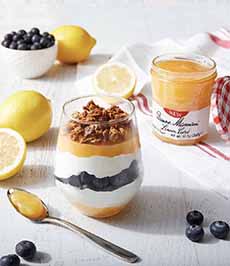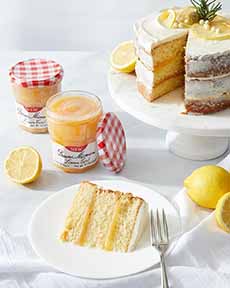TIP OF THE DAY: Lemon Curd Recipe & History
|
|
This tip is about lemon curd, but you can make fruit curds from any fruit that can be juiced (berries*, lime, grapefruit, orange, passionfruit, pineapple, mango, etc.) Lemon is the most common, but the others are just as delicious. There are some good store-bought lemon curds, but they are nowhere as good as homemade. Commercial lemon curds may also include thickeners (such as cornstarch; these dilute the flavor and quality of lemon curd), preservatives, colors, and flavorings. And it’s so easy to make: four basic kitchen ingredients and 10 minutes on the stove. (It’s five ingredients if you count lemon juice and zest separately.) Lemon curd is one of those foods that are so seductive, you can eat them by the spoonful from the jar. Curd is a bread spread and filling for baked goods, but it’s slightly different from jelly, jam and preserves. Lemon curd is a probably best known for serving with scones at afternoon tea. But that’s just one of the numerous ways to enjoy lemon curd. Some of the best lemon curds are made with the zest and sweeter juice of Meyer lemons. However, they are seasonal; November through May. Don’t let that stop you from making them from supermarket Eureka or Lisbon lemon varieties (the different types of lemons). This recipe is courtesy of Taste Of Home. Ingredients 1. WHISK together in a small heavy saucepan over medium heat, the eggs, sugar and lemon juice. Stir until blended. 2. ADD the butter and lemon zest. Cook, whisking constantly, until the mixture is thickened and coats the back of a metal spoon. 3. TRANSFER to a bowl; or to store, place in a clean container with a lid. Cool for 10 minutes. Refrigerate, covered, until cold. The first written mention of lemon curd appears in England in 1844, in The Lady’s Own Cookery Book by Lady Charlotte Campbell Bury. This early recipe is different from today’s lemon curd. It is literally curds: lemon juice added to cream to form curds. The curds were then be separated from the whey through cheesecloth. Although still called curd, today’s recipe evolved to a velvety custard spread, made with by the combination of lemon, sugar, eggs and butter. If you read U.K. articles, you may come across mentions of lemon cheese instead of lemon curd. There is no technical or legal difference between the two. They contain the same ingredients and are cooked the same way. |
|
|
|
||








